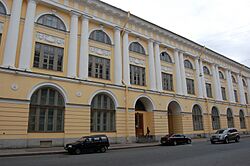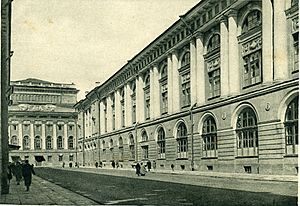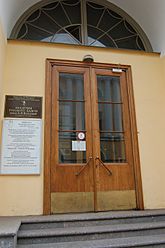Vaganova Academy of Russian Ballet facts for kids
Quick facts for kids Vaganova Academy of Russian Ballet |
|
|---|---|
 |
|
| Location | |
|
|
|
| Coordinates | 59°55′49″N 30°20′09″E / 59.9303°N 30.3358°E |
| Information | |
| Type | Ballet school |
| Established | May 4, 1738 |
| Campus type | Urban |
| Website | https://vaganovaacademy.ru/ |
The Vaganova Academy of Russian Ballet is a famous school for classical ballet in St Petersburg, Russia. It started way back in 1738. This was during the time of Empress Anna.
For a long time, the school was called the Imperial Ballet School. Later, during the Soviet era, it got a new name: the Leningrad State Choreographic Institute. In 1957, the school was renamed to honor Agrippina Vaganova. She was a brilliant teacher who created a special way of teaching ballet. This method has been used there since the 1920s. Many top ballet schools around the world now use parts of the Vaganova method.
The Vaganova Academy is connected to the Mariinsky Ballet. This is one of the best ballet companies in the world. Students from the Vaganova Academy often get jobs with famous ballet groups. These include the Bolshoi Ballet, The Royal Ballet, and American Ballet Theatre.
Contents
History of the Vaganova Ballet School
The school began as the Imperial Theatrical School. Empress Anna officially started it on May 4, 1738. A French Ballet Master named Jean-Baptiste Lande was its first director. The very first classes were held in empty rooms at the Winter Palace in St. Petersburg. There were twelve boys and twelve girls as the first students.
Most of the early teachers came from Western Europe. These included Franz Hilferding and Giovanni Canzianni. The first Russian teacher to join the school was Ivan Valberg. As ballet grew popular in Europe, many other teachers helped the school develop. Important teachers included Christian Johannson and those who taught Italian methods like Enrico Cecchetti. Other famous dancers and ballet masters from the 1800s also taught there. They helped shape the school's unique style. Some of these were Charles Didelot, Marius Petipa, and Mikhail Fokine.
Since 1836, the school has been located at 2 Rossi Street in St. Petersburg. After 1924, St. Petersburg was known as Leningrad. The original Imperial Ballet School was closed by the new Soviet government. But it was soon reopened in the same place. It was then called the Leningrad State Choreographic School. The Imperial Russian Ballet company also changed its name. It became the Soviet Ballet. Later, it was renamed the Kirov Ballet in 1934. Today, it is officially the Mariinsky Ballet, but many still call it the Kirov Ballet.
Agrippina Vaganova and Her Method
Agrippina Vaganova made big changes in modern Russian Ballet. She finished her studies at the Imperial Ballet School in 1897. She danced with the Imperial Ballet for a while. Then, after the Revolution, she stopped dancing to focus on teaching. The Soviet government had not yet reopened the school. So, Vaganova started teaching at a private school. In 1920, she joined the new Leningrad State Choreographic School.
Vaganova wrote an important book called The Principles of Classical Dance. This book explains the special training system she created. This system is now known as the Vaganova method. The school has had a few different names over the years. But its official name in English today is the Vaganova Ballet Academy.
The Vaganova Academy Today
What the Academy is Like Now
The Vaganova Ballet Academy is considered a very important place for modern ballet. It is now more than 275 years old! The Academy has over 300 students. The main leader of the academy is Nikolay Tsiskaridze. The Artistic Director, who guides the artistic side, is Zhanna Ayupova.
How Students Train at the Academy
All students at the school start with a special program. They learn dance training and also get a regular secondary school education. They also take French language and piano lessons. As students get better, their training becomes more intense. New subjects are added to their lessons.
Students are tested at the end of each school year. Based on their progress, a decision is made about whether they will move to the next grade. The higher grades have fewer spots available.
See also
 In Spanish: Academia Vaganova de Ballet para niños
In Spanish: Academia Vaganova de Ballet para niños



